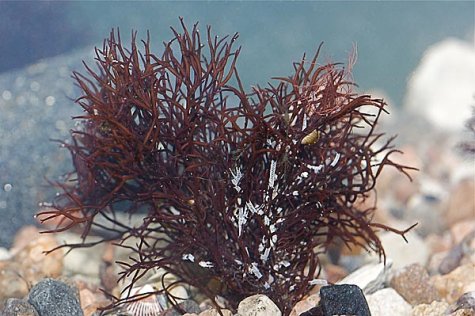Furcellaria thrown ashore
Photo: Tiit Hunt
Translation: Liis
Furcellaria
Furcellaria; Baltic agar; black carrageen Agarik; furtsellaria Furcellaria lumbricalis
Drifting or unattached variety of Furcellaria, lacking anchor Agariku nn lahtine vorm ilma talluseta Furcellaria lumbricalis f. aegagropila
The first autumn storm with the stately name of St Jude is history today; beautiful autumn days are still to come on which to go roaming on the seashore.
The Furcellaria, Baltic agar or black carrageen is our only “edible” seaweed [in the Baltic] – a reddish brown until nearly black-coloured alga belonging to the red algae, Rhodophyta. It can be found washed up from the sea along almost the whole coast where storms have carried the plants ashore. Furcellaria grows up to some twenty centimetres tall. Each growing branch divides into two – this regularity none of our other algae shows (see Tiit’s photo). Thus no problems with identification.
From Furcellaria fucellarine can be made, a gelling polysaccharide that is used as a gelatinizer in foods: an additive in the manufacture of marmalades and sefyr as well as dairy products. On the food packaging the code E406 is noted in that case.
On a hard seabed Furcellaria can grow attached to bladderwrack, starting at a depth of a metre and until depths of some twenty metres. The so-called floating or unattached Furcellaria form grows in the Sounds Sea (Väinameri) where the sea bottom is softer; externally both forms are identical.









